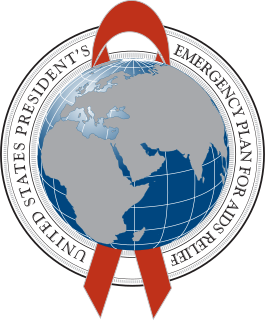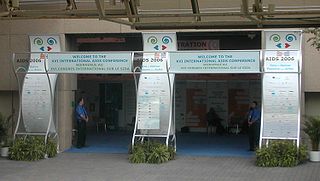
The AIDS epidemic, caused by HIV, found its way to the United States as early as 1960, but was first noticed after doctors discovered clusters of Kaposi's sarcoma and pneumocystis pneumonia in young gay men in Los Angeles, New York City, and San Francisco in 1981. Treatment of HIV/AIDS is primarily via a "drug cocktail" of antiretroviral drugs, and education programs to help people avoid infection.

The President's Emergency Plan For AIDS Relief (PEPFAR) is a United States governmental initiative to address the global HIV/AIDS epidemic and help save the lives of those suffering from the disease. Launched by U.S. President George W. Bush in 2003, PEPFAR has provided more than $80 billion in cumulative funding for HIV/AIDS treatment, prevention, and research since its inception, making it the largest global health program focused on a single disease in history. PEPFAR is implemented by a combination of U.S. government agencies in over 50 countries and overseen by the Global AIDS Coordinator at the U.S. Department of State. It is widely credited with having helped save millions of lives, primarily in Sub-Saharan Africa.
The International AIDS Society (IAS) is an association of HIV professionals, with 11,035 members from more than 160 countries working at all levels of the global HIV response. Its mission is to lead collective action on every front through its membership base, scientific authority and convening power. IAS members include researchers from all disciplines, clinicians, public health and community practitioners on the frontlines of the epidemic, as well as policy makers and programme implementers.
This is a timeline of AIDS, including AIDS cases before 1980.

AIDS is caused by a human immunodeficiency virus (HIV), which originated in non-human primates in Central and West Africa. While various sub-groups of the virus acquired human infectivity at different times, the global pandemic had its origins in the emergence of one specific strain – HIV-1 subgroup M – in Léopoldville in the Belgian Congo in the 1920s.

The XVI International AIDS Conference was held in Toronto, Ontario, during the week of 13–18 August 2006. This was the third time that Canada has hosted the International AIDS Conference, after Montreal in 1989 and Vancouver in 1996. The main venue for the conference was the Metro Toronto Convention Centre (MTCC) in downtown Toronto.

amfAR, the Foundation for AIDS Research, known until 2005 as the American Foundation for AIDS Research, is an international nonprofit organization dedicated to the support of AIDS research, HIV prevention, treatment education, and the advocacy of AIDS-related public policy.

Human immunodeficiency virus infection and acquired immune deficiency syndrome (HIV/AIDS) is a spectrum of conditions caused by infection with the human immunodeficiency virus (HIV). Following initial infection, a person may not notice any symptoms or may experience a brief period of influenza-like illness. Typically, this is followed by a prolonged period with no symptoms. As the infection progresses, it interferes more with the immune system, increasing the risk of developing common infections such as tuberculosis, as well as other opportunistic infections, and tumors that rarely affect people who have uncompromised immune systems. These late symptoms of infection are referred to as acquired immunodeficiency syndrome (AIDS). This stage is often also associated with unintended weight loss.

Joseph Marie Albert "Joep" Lange was a Dutch clinical researcher specialising in HIV therapy. He served as the president of the International AIDS Society from 2002 to 2004. He was a passenger on Malaysia Airlines Flight 17, which was shot down on 17 July 2014 over Ukraine.

HIV/AIDS is the most serious health concern in South Africa. The country has the highest number of people afflicted with HIV of any country, and the fourth-highest adult HIV prevalence rate, according to the 2016 United Nations statistics.
Robert Rayford, sometimes identified as Robert R. due to his age, was a teenager from Missouri who has been suggested to represent the earliest case of HIV/AIDS in North America based on evidence published in 1988 in which the authors claimed indicated he was "infected with a virus closely related or identical to human immunodeficiency virus type 1." Rayford died of pneumonia, but his other symptoms baffled the doctors who treated him. A study published in 1988 reported the detection of antibodies against HIV. Results of testing for HIV genetic material were reported once at a scientific conference in Australia in 1999; however, the data have never been published in a peer-reviewed medical or scientific journal.

The history of HIV/AIDS in Australia is distinctive, as Australian government bodies recognised and responded to the AIDS pandemic relatively swiftly, with the implementation of successful disease prevention and public health programs, such as needle and syringe programs (NSPs). As a result, despite significant numbers of at-risk group members contracting the disease in the early period following its discovery, the country achieved and has maintained a low rate of HIV infection in comparison to the rest of the world.
NMAC, formerly known as the National Minority AIDS Council, leads with race to urgently fight for health equity and racial justice to end the HIV epidemic in America. The nonprofit organization located in Washington, D.C., was founded in 1987. NMAC represents over 3,000 community- and faith-based organizations nationwide. The agency advances its mission by providing minority and minority-serving faith- and community-based organizations a variety of capacity building assistance programs, online and classroom-based trainings, printed and electronic resources, grassroots organization and political advocacy. These activities help these agencies deliver HIV/AIDS services more efficiently and effectively, ultimately helping to mitigate the impact of HIV/AIDS in underserved and marginalized communities.

Like other countries worldwide, HIV/AIDS is present in Ghana. As of 2014, an estimated 150,000 people infected with the virus. HIV prevalence is at 1.37 percent in 2014 and is highest in the Eastern Region of Ghana and lowest in the northern regions of the country. In response to the epidemic, the government has established the Ghana AIDS Commission which coordinates efforts amongst NGO's, international organizations and other parties to support the education about and treatment of aids throughout Ghana and alleviating HIV/AIDS issues in Ghana.
The HIV/AIDS epidemic in Ukraine is one of the fastest growing in the world. Ukraine has one of the highest rates of increase of HIV/AIDS cases in Eastern Europe and highest HIV prevalence outside Africa. Experts estimated in August 2010 that 1.3 percent of the adult population of Ukraine was infected with HIV, the highest in all of Europe. Late 2011 Ukraine numbered 360,000 HIV-positive persons. Between 1987 and late 2012 27,800 Ukrainians died of AIDS. In 2012 tests revealed 57 new cases of HIV positive Ukrainians each day and 11 daily AIDS-related deaths.

Françoise Barré-Sinoussi is a French virologist and Director of the Regulation of Retroviral Infections Division and Professor at the Institut Pasteur in Paris, France. Born in Paris, France, Barré-Sinoussi performed some of the fundamental work in the identification of the human immunodeficiency virus (HIV) as the cause of AIDS. In 2008, Barré-Sinoussi was awarded the Nobel Prize in Physiology or Medicine, together with her former mentor, Luc Montagnier, for their discovery of HIV. She mandatorily retired from active research on August 31, 2015 and fully retired by some time in 2017.
The portrayal of HIV and AIDS in the media refers to events and trends in the discussion of HIV and AIDS in mass media. HIV leads to a large amount of illness and many deaths. It is unique from most other diseases because there is stigma and discrimination surrounding those affected with the disease. The transmission of HIV, however, is extremely preventable and the media is a very effective way to convey this information. The UNESCO report on Journalism Education says, “Well researched television content can create public awareness about HIV prevention, treatment, care and support can potentially influence the development and implementation of relevant policies.”
Julio S. G. Montaner, is an Argentinean-Canadian physician, professor and researcher. He is the director of the British Columbia Centre for Excellence in HIV/AIDS, the chair in AIDS Research and head of the Division of AIDS in the Faculty of Medicine at the University of British Columbia and the past-president of the International AIDS Society. He is also the director of the John Ruedy Immunodeficiency Clinic, and the Physician Program Director for HIV/AIDS PHC. He is known for his work on HAART, a role in the discovery of triple therapy as an effective treatment for HIV in the late 1990s, and a role in advocating the "Treatment as Prevention" Strategy in the mid-2000s, led by Myron Cohen of the HPTN 052 trial..
Peter Ndimbirwe Mugyenyi, MBChB, DCH, FRCPI, FRCPE, ScD, commonly known as Peter Mugyenyi, is a Ugandan physician, HIV/AIDS researcher, medical administrator and author. He is the Executive Director and Co-Founder of the Joint Clinical Research Centre (JCRC), and a leading International authority on treatment of HIV/AIDS in Africa.













